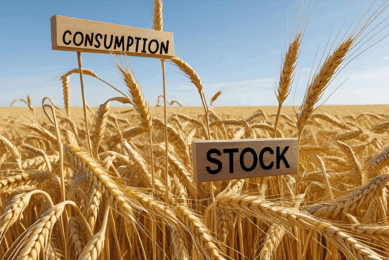4.3% decline in world wheat production

The global wheat supply and demand balance is forecast to tighten in 2018/19, as evidenced by firmer international prices compared to the previous season.
This is according to the Food Outlook, the biannual report on global food markets, published by FAO.
4.3% decline from the 2017 record level
The forecast for global wheat production in 2018 has been revised downwards in recent months, and is now pegged at 727.9 million tonnes, 4.3% decline from the 2017 record level. The EU, the Russian Federation, China and Australia account for much of the year-on-year contraction. They are also behind the recent lowering in the global production outlook, while prospects improved in North and South America.
4.5% decline in wheat inventories
Total wheat utilisation is expected to increase only marginally in 2018/19, with the global growth in wheat feed use affected by lower intakes in the Russian Federation and Ukraine, mostly due to reduced domestic supplies and less attractive prices. However, global wheat use for food consumption is seen increasing by 1.0%, which should result in a relatively stable average per capita level. With world production forecast to fall below overall utilisation, global wheat inventories in 2019 are anticipated to register a 4.5% decline from their record high opening level. The drawdown is expected to be concentrated among the major exporters, in particular the Russian Federation, the EU and the US, more than offsetting significant buildups expected in China and, to a lesser extent, in India. Consequently, the ratio of major wheat exporters’ closing stocks to their total disappearance (defined as domestic utilisation plus exports) – a measure of global market availabilities – is set to fall to a five-year low of 16.3%.
World wheat trade
Contrary to earlier predictions, world wheat trade is now forecast to contract in 2018/19 (July/June), albeit from the record levels achieved in the past 2 seasons. Among importers, Algeria, India and South Africa are anticipated to curb their wheat purchases in the wake of larger domestic harvests. As for exports, shipments from the Russian Federation are set to contract, reflecting a fall in domestic production. Similarly, wheat exports from Australia, the EU and Ukraine are anticipated to decline, which would more than counter a notable rebound of foreign sales by the United States, as well as bigger shipments from Argentina and Canada.
Source: FAO











